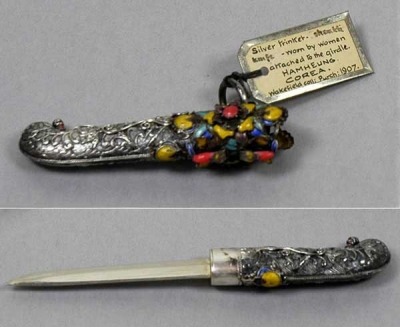Jang Do (1907.80.15)
 KoreaJang Do from Korea, Asia. Collected by S. Wakefield. Purchased by the Museum in 1907.
KoreaJang Do from Korea, Asia. Collected by S. Wakefield. Purchased by the Museum in 1907.
This is a miniature knife (just over 10cm long) worn by Korean women both as a means of self-defence and, thanks to their highly ornate appearance, as items of jewellery.
Defining Gender
The carrying of highly ornamental knives by men and women became popular in Korea during the second half of the long Choson period (1392-1910). Traditionally, these small, relatively concealed knives, known as jang do, were presented to young women before their wedding night by their parents, in order to provide them with a means by which to prevent rape. This reflects the newly married woman passing from the protection of her parents into fully independent adult status. Therefore, we can see that the jang do was intended to be both discrete and noticeable; a symbol of marital status, fidelity and personal honour as well as a visual warning to potential assailants.
Usually, men wore such knives slung from the belt and although the hand-written label suggests it was worn on the girdle, most women either wore their jang do hung from a woven silk strap at the front of their clothing, much like a necklace, or carried them in their personal bag. Jang do usually also featured a silk tassel, which could be knotted in elaborate ways, although these are often missing on antique knives such as this one.
Jang do are justly considered to be one of the highest achievements of Korean metal- and silverwork, and often feature the working and insetting of semi-precious stone as well as a type of enamelling called cloisonné. In this example the silver filigree is in the form of cloud-scrolls whilst flowers are formed out of enamel and red glass imitating coral. Examples also exist with hilts in wood, bone, coral, gold and silver. The blades themselves are tempered and annealed for hardness and flexibility, and are highly functional.





